Under the Roman Influence
A proverbial dip into some of the archaeological evidence for Bronze and Iron Age Nordic beverages, primarily in the form of residue on the inside of drinking vessels and containers, suggest that these Nordic cultures were far from purists when it came to what they drank. The residue bears witness to the spectral presence of berries, malt from beer, and pollen and wax from honey mead. There are also occasional traces of wine, and pitch that could either be used to flavor the beverages, but probably as a sealant for the vessels. Wine, of course, being telltale of contact with the mediterranean.
While it is impossible to tell whether or not all of this was contained in the vessels at once, there are enough of these examples to suggest that people living in prehistoric, Bronze Age, and Iron and Dark Age Northern Europe, consumed mixed beverages, often referred to as Nordic grog by the venerable professor Patrick McGovern, who refers to them in such classics as Ancient Wine, Uncorking the Past, and lastly, Ancient Brews - the most recent addition to his bibliography.
I've not read that last one, but you should definitely read the former if you're interested in history, fermented beverages, the history of fermented beverages, or the fermented beverages of history. Let me rephrase that: If you are culturally conscious person person who eats and drinks, then you should read at least one of these books, or die. If you are a scholar, you should buy Uncorking the Past, sit down with a typewriter, and retype every word of it. You will have grown as an educator by the end of it.
There are a lot of opinions about what constitutes a so-called serious academic. I believe it is one who takes his or her material so seriously, that they cannot help but reach out to the public. Who are unafraid of breaking the mold. McGovern is just that, as his impassioned, amiable writing style demonstrates. His books achieve to be both pioneering academic text books, and page turners.
Anyway, my friend and I were chatting. We were already somewhat tipsy on his homemade Roman inspired mulled wine. An earthy, spicy beverage he had fashioned from amphora-fermented Sicilian nectar. As it ran out we decided to return to our barbarian roots and recreate a drink we'd enjoyed many times before, usually by an open fire under the blushing sky of long Norwegian summer nights. This simple, contemporary interpretation of Nordic grog requires only two ingredients: Red wine and lager beer.
Our choice of ingredients was unpretentious, in true barbarian fashion. The wine came from a Shetland duty free, apparently branded by the store itself. If I recall, I found it somewhat dry and earthy, yet not too heavy on the tannins. Online reviews absolutely slaughter it. We topped it off with Faxe Premium. This Danish pilsner was a no brainer given the horned viking adorning the can.
The result was, according to the words of my companion, the best of both worlds: A drink that achieves to be both diluted wine, and fortified beer, satisfying Roman, as well as barbarian thirsts in equal measure! Like a patrician in the gutter in the final days of Rome. Mind you, the wine provides a better complement to the beer than the beer does to the wine, leaving a wine-heavy product laced with the light head and tapered fizz of the danish pilsner. While both ingredients matter as they need to balance each other, don't go overboard with the choice of wine. Save your wallet. Even then it feels significantly fancier to drink than the beer would have felt on its own, as it proved to be quite silky and easy on the tongue.
Recipe: The noble Savage
1 parts dry, young red wine
1 parts pilsner or similar lager beer
Preparation:
1. Chill the ingredients slightly
2. Pour stoically into a glass drinking bowl,
(Alternately: a highball glass)
3. Mix carefully, don't spill a drop!
4. Sip medio-slowly
Suggested pairings:
Cured ham, gift exchange and blood oaths.
If you would like to hear Aksel's favorite recipe for Roman spiced wine, pledge your support over at the Brute Norse Patreon page.






















